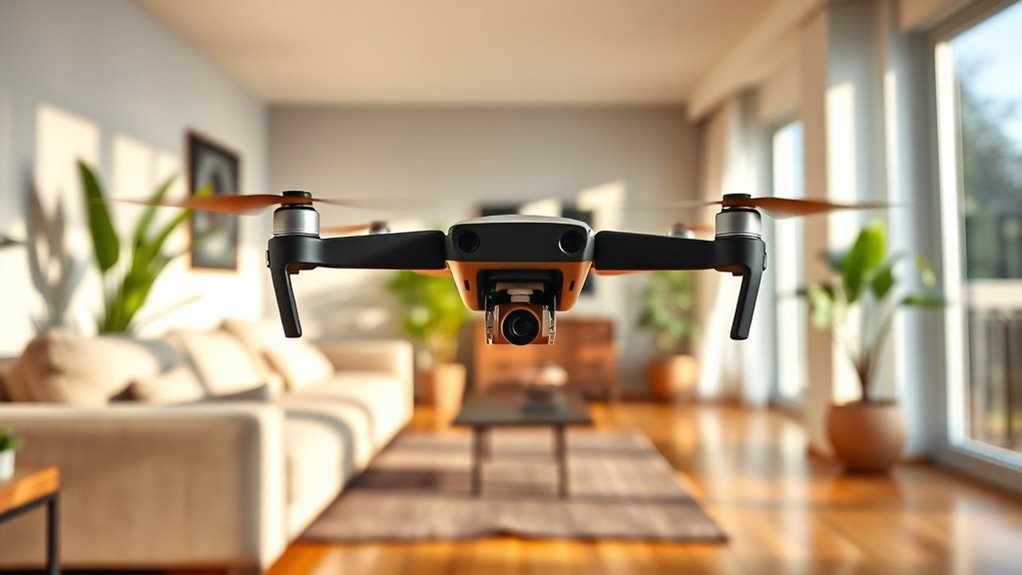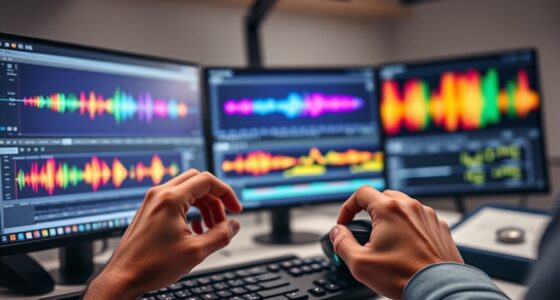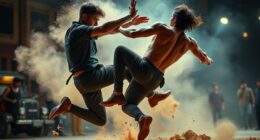To capture mini drone shots indoors safely, start by clearing your space of clutter, furniture, and obstacles, and guarantee windows and doors are closed. Keep the drone at manageable altitudes and avoid flying too close to ceilings, walls, or hands. Use propeller guards and practice gentle movements to maintain control. Experiment with angles and lighting for cinematic shots while always prioritizing safety. Continue exploring more tips to master both creative and secure indoor drone filming.
Key Takeaways
- Clear the area of clutter and obstacles before flying to prevent crashes.
- Maintain a safe distance from people, fragile items, and walls during indoor flights.
- Use propeller guards and operate at low altitudes to enhance safety.
- Practice smooth, controlled movements and develop a flight plan for better shots.
- Prioritize safety by understanding your drone’s specifications and following established safety guidelines.

Indoor mini drone shots have become an exciting way to capture dynamic footage in tight spaces. Whether you’re filming a home project, a small event, or just experimenting with creative angles, these tiny drones open up a world of possibilities. However, flying a mini drone indoors requires careful attention to flight safety and camera angles to make certain you get great shots without risking damage or injury.
First and foremost, flight safety should be your top priority. Indoors, obstacles like furniture, ceilings, and even your own hands can pose a risk. Before you start flying, clear the area of any clutter that could interfere with the drone’s movement. Make sure windows and doors are closed to prevent accidental escapes. Keep a safe distance from fragile items, and consider using propeller guards for added protection. Always operate the drone at a manageable altitude and avoid flying too close to people. If you’re new to indoor drone flying, practice hovering and gentle turns first to build confidence and control. Remember, rushing can lead to crashes that damage your equipment or cause injury, so take your time to familiarize yourself with the drone’s responsiveness. Incorporating flight safety guidelines** can help prevent accidents and ensure a smooth shooting experience. Additionally, understanding mini drone specifications** can assist in selecting the right drone for indoor use.
Prioritize safety: clear clutter, close windows, keep distance from fragile items, and practice gentle maneuvers indoors.
When it comes to camera angles, the beauty of mini drones is their agility. Use this to your advantage by experimenting with different perspectives. Low shots from just above the ground can add a dramatic feel, while overhead shots can showcase the layout of a room or highlight specific details. Moving the drone smoothly between angles helps create cinematic footage, so practice slow, controlled movements. Additionally, think about lighting; good illumination will enhance your footage and prevent shaky, grainy shots. Pay attention to how the drone’s camera captures space and use that to tell a story or emphasize particular elements in your scene. To optimize your filming, understanding proper drone handling techniques and creative camera angles can help improve your control and safety. Developing a flight plan before flying can also help you execute shots more efficiently and safely.
Balancing flight safety with creative camera angles takes practice, but it’s worth the effort. Always start with simple movements and gradually push your skills further. Keep a close eye on the drone’s battery life to avoid losing control mid-flight. Remember, the goal is to capture compelling shots while keeping everyone safe and the environment intact. With patience and attention, you can master indoor mini drone shots that are both visually stunning and safe to execute. Keep safety guidelines in mind, and don’t be afraid to experiment with angles—your creative vision is the limit.
Frequently Asked Questions
What Are the Best Drone Models for Indoor Filming?
When choosing the best drone models for indoor filming, look for compact, agile options like the DJI Mini 3 Pro or Skydio 2. These drones excel in maneuverability and stability, making them ideal for tight spaces. Remember, proper drone maintenance guarantees consistent performance, and mastering aerial photography techniques helps you capture stunning shots. Always practice safety, especially indoors, to prevent accidents and keep your gear in top condition.
How Can I Prevent My Drone From Crashing Indoors?
To prevent your drone from crashing indoors, always use propeller guards to protect blades and surroundings. Enable obstacle sensors to help detect and avoid walls, furniture, or other objects. Fly at a slow, steady pace and keep the drone within your line of sight. Practice in open areas first, then gradually navigate tighter spaces. These steps help guarantee safe, controlled indoor flights and protect your equipment from damage.
What Safety Gear Should I Use During Indoor Drone Shoots?
Ever wondered what safety gear keeps you protected during indoor drone shoots? You should definitely wear safety goggles to shield your eyes from unexpected crashes or flying debris. Protective gloves can also help prevent cuts if you need to handle the drone or tricky cables. Do you really want to risk injury when simple gear like goggles and gloves can keep you safe? Stay prepared and enjoy your indoor filming adventure!
How Do I Manage Indoor Lighting for Drone Footage?
To manage indoor lighting for drone footage, you should optimize both natural and artificial light sources. Use natural light by shooting near windows during the day, but control glare with curtains or diffusers. Supplement with soft artificial lighting to fill shadows and guarantee consistent exposure. Adjust your drone’s camera settings accordingly, balancing ISO and shutter speed, so your footage stays clear and vibrant, regardless of changing light conditions.
Are There Legal Restrictions for Indoor Drone Filming?
Think of indoor drone filming as dancing in a crowded room—you must respect the space and others’ privacy. While there aren’t strict laws for indoor filming, privacy concerns and local regulations still matter. You should keep your shots respectful and avoid capturing private moments without permission. Always check local rules and confirm you’re not infringing on anyone’s privacy, so your creative dance stays safe and legal.
Conclusion
Now that you’ve mastered capturing mini drone shots indoors, think of your drone as an artist’s brush, painting intricate scenes in the tightest of spaces. With careful navigation and respect for your surroundings, you transform confined rooms into vibrant canvases of motion and light. Remember, safety is your guiding star—letting your creativity soar without risking a fall. Embrace the dance of precision and imagination, turning every indoor shot into a symphony of miniature marvels.








